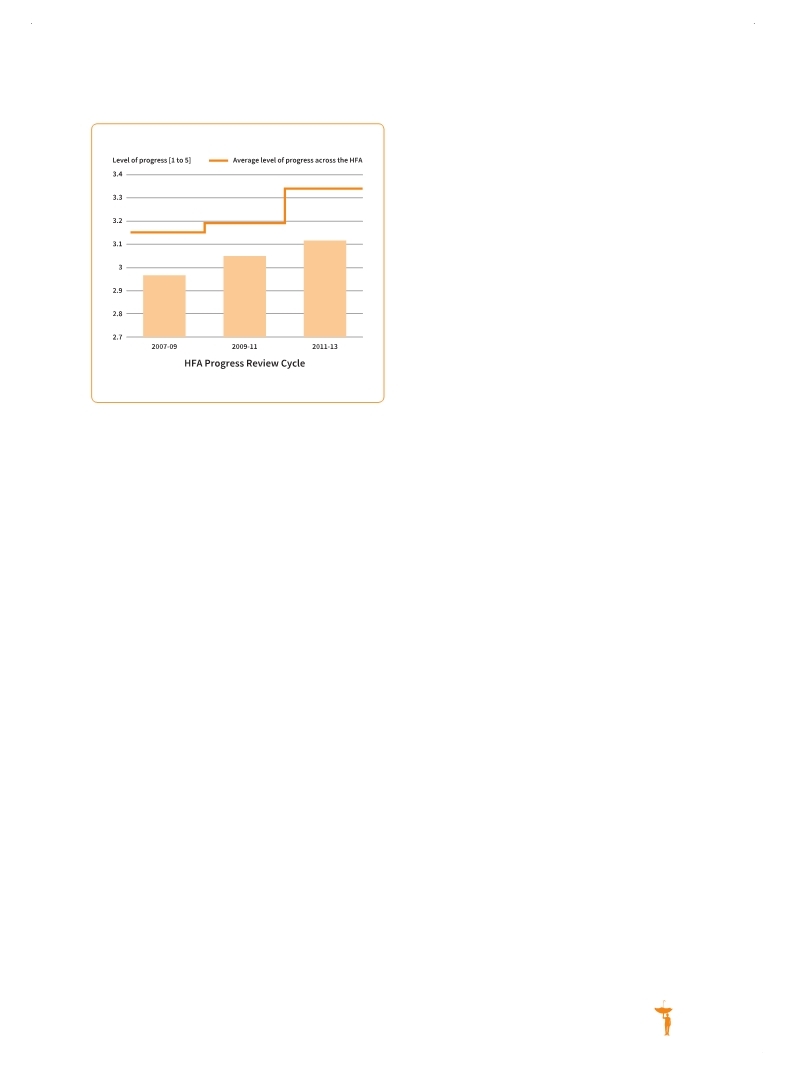 |
Global Assessment Report on Disaster Risk Reduction 2015
Making development sustainable: The future of disaster risk management |
 |
Global Assessment Report on Disaster Risk Reduction 2015
Making development sustainable: The future of disaster risk management |
|
|

167
(Source: UNISDR with data from the HFA Monitor.)
Figure 8.4 Progress in integration of DRR in recovery and rehabilitation
For example, the International Recovery Platform (IRP) was announced at the Second World Conference for Disaster Reduction in Kobe, Japan as a mechanism to identify gaps and constraints experienced in post disaster recovery and to serve as a catalyst for the development of tools, resources, and capacity for resilient recovery. IRP aims to be an international source of knowledge on good recovery practice.12
Soon afterwards, the Inter-Agency Standing Committee (IASC) created a Cluster Working Group on Early Recovery (CWGER) as part of a new approach to improve coordination within the UN system and between the UN and other stakeholders after major disasters. At the same time, support for national recovery planning and programming was an important component of the Global Facility for Disaster Reduction and Recovery (GFDRR), of the former UNDP Bureau for Crisis Prevention and Recovery (BCPR) as well as similar units in other regional and international organizations. At the same time, UNDP, the World Bank and the European Union joined forces to develop a common approach to assessing
recovery needs: the Post-Disaster Needs Assessment and Recovery Framework (PDNA/RF).
In search of space
When disaster occurs, an enormous quantity of accumulated risk is liberated. On the one hand, this vast energy is destructive. But on the other hand, it creates a space where new possibilities can emerge. How this space can be used is the fundamental challenge facing post-disaster recovery. The experience of recovery and reconstruction highlights just how difficult it is to take advantage of the window of opportunity that opens in the space or gap after a disaster and to ensure that new development prevents and avoids risks rather than reconstructing them.
A first set of problems refers precisely to the length of the gap or space between the destruction of the disaster and new development. This has variously been described as the gap between relief and recovery or the relief to development continuum (Buchanan-Smith and Maxwell, 1994
Buchanan-Smith, Margaret and Simon Maxwell. 1994,Linking Relief and Development: An introduction and overview. . Longhurst, Richard. 1994,Conceptual Frameworks for Linking Relief and Development, IDS Bulletin, Vol. 25, No. 4: 17-23.. . UNISDR. 2009a,Global Assessment Report on Disaster Risk Reduction: Risk and Poverty in a Changing Climate, Geneva, Switzerland: UNISDR.. . Recovery, therefore, raises key issues in compensatory risk management, in particular whether mechanisms are in place which can allow households, businesses and governments to
HFA Core Indicator 4.5: DRR measures integrated into post-disaster recovery and rehabilitation.
|
 
Page 1Page 10Page 20Page 30Page 40Page 50Page 60Page 70Page 80Page 90Page 100Page 110Page 120Page 130Page 140Page 150Page 157Page 158Page 159Page 160Page 161Page 162Page 163Page 164Page 165Page 166Page 167Page 168->Page 169Page 170Page 171Page 172Page 173Page 174Page 175Page 176Page 177Page 178Page 179Page 180Page 181Page 190Page 200Page 210Page 220Page 230Page 240Page 250Page 260Page 270Page 280Page 290Page 300Page 310
|
|
 
|
 
|
